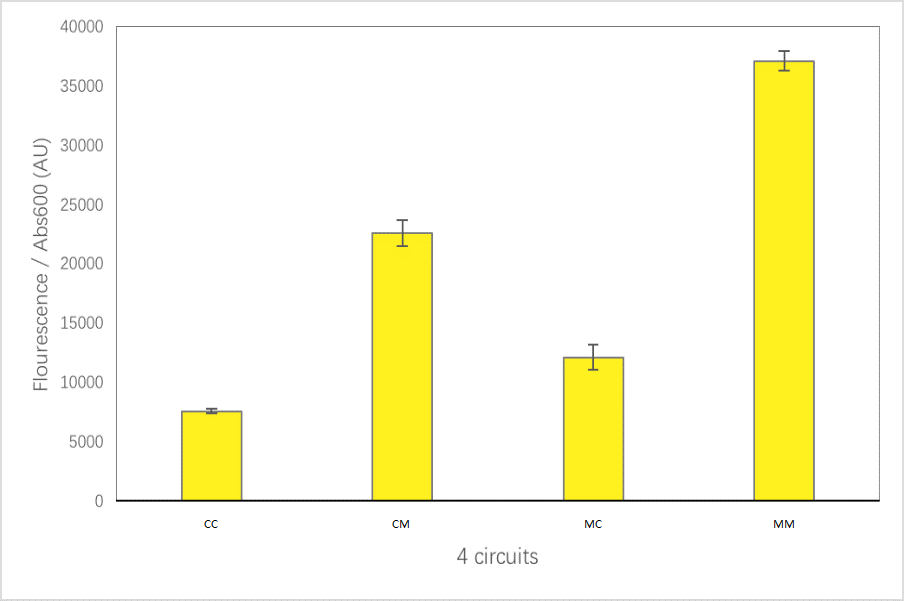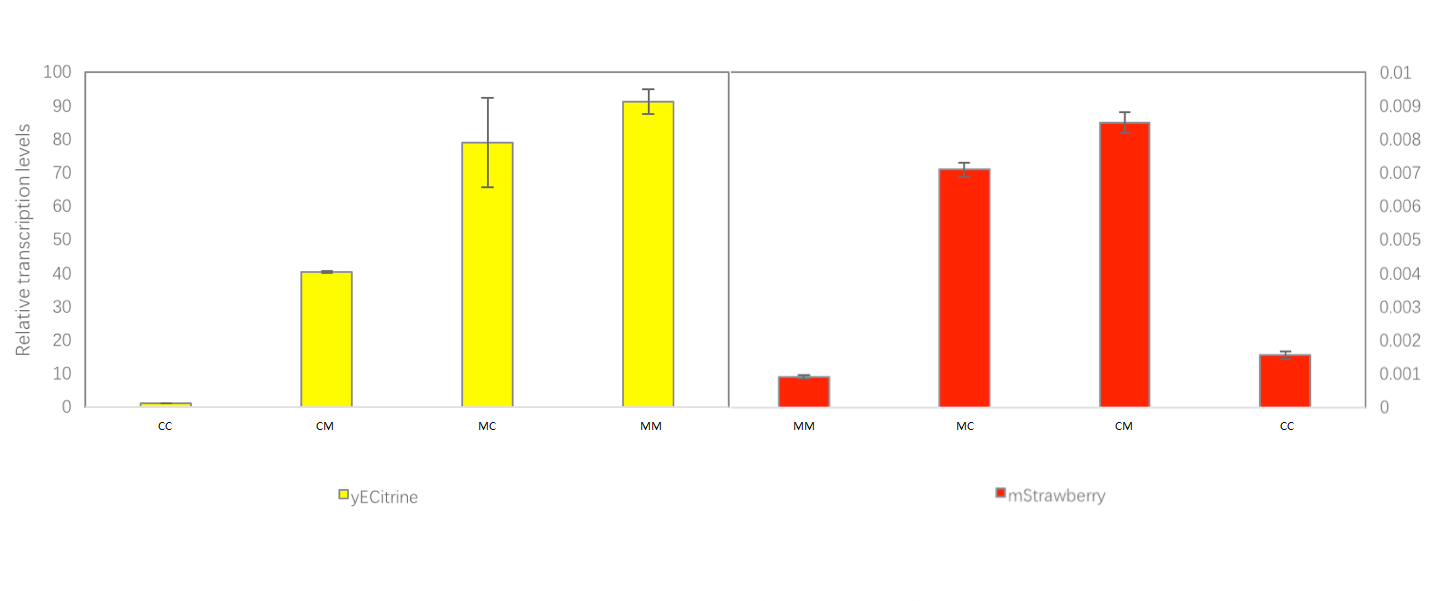Difference between revisions of "Part:BBa K2314608"
A357034555 (Talk | contribs) |
A357034555 (Talk | contribs) |
||
| (12 intermediate revisions by 2 users not shown) | |||
| Line 3: | Line 3: | ||
"Terminators are essential components in expression cassettes and can influence net protein output by controlling mRNA half-life. Mechanistically, eukaryotic terminators signal and recruit the machinery responsible for stopping transcription, cleaving the nascent mRNA, and polyadenylating the mRNA. In addition, a terminator is the genetically encoded element that defines the 3′ untranslated region (UTR) sequence and structure and thus contributes to mRNA stability and corresponding mRNA half-life. However most of native terminators in yeast are too long, usually have hundreds of base pairs. With the development of synthetic biology, synthetic terminators that possess little homology to the native genome are becoming important. What’s more, a terminator that has a much shorter sequence with the same efft of sequence is also important. [1] | "Terminators are essential components in expression cassettes and can influence net protein output by controlling mRNA half-life. Mechanistically, eukaryotic terminators signal and recruit the machinery responsible for stopping transcription, cleaving the nascent mRNA, and polyadenylating the mRNA. In addition, a terminator is the genetically encoded element that defines the 3′ untranslated region (UTR) sequence and structure and thus contributes to mRNA stability and corresponding mRNA half-life. However most of native terminators in yeast are too long, usually have hundreds of base pairs. With the development of synthetic biology, synthetic terminators that possess little homology to the native genome are becoming important. What’s more, a terminator that has a much shorter sequence with the same efft of sequence is also important. [1] | ||
| − | For the construction of terminators in yeast, | + | For the construction of terminators in yeast, Guo et al. has determined the elements and demonstrated functional termination and mature mRNA formation. 3’-end formation of yeast mRNAs involves signals having the following three degenerate elements: (i) the efficiency element, which functions by enhancing the efficiency of positioning elements; (ii) the positioning element, which positions the poly(A) site; and (iii) the actual site of polyadenylation.[2] |
| − | In our project, | + | In our project, We used the synthetic terminator Tmini with promoter Pmini (BBa_K2314831) to construct a minimal genetic regulatory element “MINI-GRE“ combination. We also selected a commonly used promoter CYC1 and terminator CYC1, and contrusted four circuits to measure the performance of MINI-GRE combination. The fluorescent protein yECitrine (BBa_K2314024)was selected as the reporter protein. More details can be viewed in our project page. |
| − | We | + | |
[1] Curran K A, Morse N J, Markham K A, et al. Short Synthetic Terminators for Improved Heterologous Gene Expression in Yeast[J]. Acs Synthetic Biology, 2015, 4(7):824. | [1] Curran K A, Morse N J, Markham K A, et al. Short Synthetic Terminators for Improved Heterologous Gene Expression in Yeast[J]. Acs Synthetic Biology, 2015, 4(7):824. | ||
| Line 12: | Line 12: | ||
| − | In short,Tmini is a very short terminator in yeast. | + | In short,Tmini is a very short terminator in yeast. It's only 68bp in length but has a good performance. |
This is the structure of Tmini. | This is the structure of Tmini. | ||
| + | https://static.igem.org/mediawiki/parts/0/09/T--OUC-China--minit.jpg | ||
| + | |||
| + | The four circuits used in our project: | ||
| + | |||
| + | [[Image:T--OUC-China--MINI-GRE_CC_PLASMID.png|800px]] | ||
| + | [[Image:T--OUC-China--MINI-GRE_CM_PLASMID.png|800px]] | ||
| + | [[Image:T--OUC-China--MINI-GRE_MC_PLASMID.png|800px]] | ||
| + | [[Image:T--OUC-China--MINI-GRE_MM_PLASMID.png|800px]] | ||
| + | |||
| + | For convenience, we named the“CYC1p-yECitrine-CYC1t-mStrawberry-CYC1t”as“CC”,“CYC1p-yECitrine-MINIt-mStrawberry-CYC1t”as“CM”,“MINIp-yECitrine-CYC1t-mStrawberry-CYC1t”as“MC”, and“MINIp-yECitrine-MINIt-mStrawberry-CYC1t” as “MM”,hereafter. | ||
| + | |||
| + | |||
| + | |||
| + | The expression level of MINI-GRE: | ||
| + | |||
| + | [[Image:Abs600_of_strains_with_different_promoter-terminator_pairs.png|800px]] | ||
| + | |||
| + | |||
| + | |||
| + | |||
| + | The qPCR result of mini system: | ||
| + | |||
| + | [[Image:T--OUC-China--MINI-GRE_qPCR_.png|800px]] | ||
| − | + | Here, the transcript level of mStrawberry is very low, which means the transcription read through of MINI terminator can be overlooked. You can learn more from our project. | |
| − | |||
<!-- Add more about the biology of this part here | <!-- Add more about the biology of this part here | ||
===Usage and Biology=== | ===Usage and Biology=== | ||
Latest revision as of 16:26, 1 November 2017
Tmini is a very short terminator in yeast. It's only 68bp in length but has a good performance.
"Terminators are essential components in expression cassettes and can influence net protein output by controlling mRNA half-life. Mechanistically, eukaryotic terminators signal and recruit the machinery responsible for stopping transcription, cleaving the nascent mRNA, and polyadenylating the mRNA. In addition, a terminator is the genetically encoded element that defines the 3′ untranslated region (UTR) sequence and structure and thus contributes to mRNA stability and corresponding mRNA half-life. However most of native terminators in yeast are too long, usually have hundreds of base pairs. With the development of synthetic biology, synthetic terminators that possess little homology to the native genome are becoming important. What’s more, a terminator that has a much shorter sequence with the same efft of sequence is also important. [1] For the construction of terminators in yeast, Guo et al. has determined the elements and demonstrated functional termination and mature mRNA formation. 3’-end formation of yeast mRNAs involves signals having the following three degenerate elements: (i) the efficiency element, which functions by enhancing the efficiency of positioning elements; (ii) the positioning element, which positions the poly(A) site; and (iii) the actual site of polyadenylation.[2] In our project, We used the synthetic terminator Tmini with promoter Pmini (BBa_K2314831) to construct a minimal genetic regulatory element “MINI-GRE“ combination. We also selected a commonly used promoter CYC1 and terminator CYC1, and contrusted four circuits to measure the performance of MINI-GRE combination. The fluorescent protein yECitrine (BBa_K2314024)was selected as the reporter protein. More details can be viewed in our project page.
[1] Curran K A, Morse N J, Markham K A, et al. Short Synthetic Terminators for Improved Heterologous Gene Expression in Yeast[J]. Acs Synthetic Biology, 2015, 4(7):824.
[2]Guo, Z. J., and Sherman, F. (1996) Signals sufficient for 3′-end formation of yeast mRNA. Mol. Cell. Biol. 16, 2772−2776."
In short,Tmini is a very short terminator in yeast. It's only 68bp in length but has a good performance.
This is the structure of Tmini.

The four circuits used in our project:
For convenience, we named the“CYC1p-yECitrine-CYC1t-mStrawberry-CYC1t”as“CC”,“CYC1p-yECitrine-MINIt-mStrawberry-CYC1t”as“CM”,“MINIp-yECitrine-CYC1t-mStrawberry-CYC1t”as“MC”, and“MINIp-yECitrine-MINIt-mStrawberry-CYC1t” as “MM”,hereafter.
The expression level of MINI-GRE:
The qPCR result of mini system:
Here, the transcript level of mStrawberry is very low, which means the transcription read through of MINI terminator can be overlooked. You can learn more from our project.
Sequence and Features
- 10COMPATIBLE WITH RFC[10]
- 12COMPATIBLE WITH RFC[12]
- 21COMPATIBLE WITH RFC[21]
- 23COMPATIBLE WITH RFC[23]
- 25COMPATIBLE WITH RFC[25]
- 1000COMPATIBLE WITH RFC[1000]






